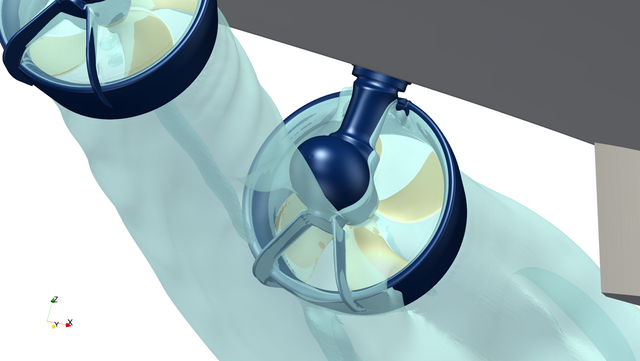The utilization of the new SCHOTTEL Dynamic RudderPropeller (SRP-D) with fast thruster response for dynamic positioning has just been endorsed by Navis Engineering Oy, the Finnish manufacturer of dynamic positioning control systems. A joint investigation focused on the mechanical capabilities of the new thruster and how well Navis’ NavDP4000 control system can be adapted to it.

During thruster-thruster interaction, simulations revealed up to 45 percent less thrust loss with a 98° inclined gearbox compared to a regular 90° gearbox.
High position accuracy in challenging situations
Previous investigations of the SRP-D with DNV and MARIN have shown that the effect of its highly dynamic thrust allocation is most evident in harsh weather conditions. These studies have also revealed that the new thruster significantly improves a vessel’s operational performance. In addition to this, Navis’ latest investigation simulated a Worst-Case Failure (WCF) scenario, examining how well the new thruster can manage such difficult situations.
Considerable improvements in station-keeping capability
Andrey Loginov, Senior DP Engineer at Navis, emphasizes “Especially for transient processes like the sudden loss of a thruster, it is essential that the remaining thrust is redistributed as quickly as possible. In the simulated WCF scenario, the fast response thrusters considerably improved the station-keeping capability and thus the operational safety of the vessel.”
No software modification necessary
A time domain simulator was used to complete the analysis. Level 3 dynamic simulations of the station-keeping capability for a DPII vessel confirmed that the NavDP4000 control system can utilize the fast steering-speeds and short ramp-up times of the SRP-D. This proves that a currently available DP control system can instantly produce improved results with the new thruster without any software modification.
Immediate utilization of physical advantages
“It is important that there is real profit at the end of the chain. While the physical advantages of the SRP-D are evident, extensive simulations have been carried out to exploit the potential of its use in realistic environmental conditions. But ultimately, we need to be certain that this potential can also be utilized in state-of-the-art DP software,” explains Jan Glas, Head of Product Management at SCHOTTEL.
Rapidly attracting attention in the CSOV market
Since the SRP-D is especially suited for use in offshore vessels, it has quickly caught the interest of the offshore industry and its partners. The Norwegian VARD Group is currently building four CSOVs for Edda Wind with the SCHOTTEL Dynamic RudderPropeller type SRP 460 D. Windcat Offshore ordered the SRP-D type 430 D for 5 vessels which will be built by the Dutch DAMEN Group. The contract contains the option on one further vessel. The projects establish the application of the SRP-D in different proven CSOV designs with a total number of 28 units on order today. The first of these vessels with SCHOTTEL’s new SRP-D is scheduled to be launched in 2025.